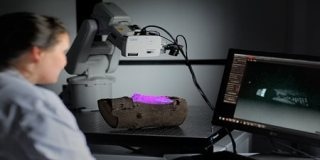Jul 29 2019
In the forestry industry, insect infestation is turning out to be an increasingly costly issue specifically in regions that experience increased hot spells and droughts associated with climate change.
 Researchers detected insect damage in wood samples using time-domain terahertz tomography performed with a robotic arm. Here, Kirsti Krügener is acquiring a reflection terahertz tomographic image measurement. (Image credit: HAWK University of Applied Science and Arts)
Researchers detected insect damage in wood samples using time-domain terahertz tomography performed with a robotic arm. Here, Kirsti Krügener is acquiring a reflection terahertz tomographic image measurement. (Image credit: HAWK University of Applied Science and Arts)
Now, a novel terahertz imaging method can help in slowing the spread of these infestations by identifying the insect-induced damage inside the wood before it becomes perceptible on the outside.
Our approach could be used to detect early-stage insect infestation on the trunks of trees, in imported wood or on wood products in an early infestation stage. This could help keep out damaging insects from other countries and stop infestation before it spreads throughout a forest.
Kirsti Krügener, Research Team Member, HAWK University of Applied Science and Arts, Germany
In the Optical Society journal Applied Optics, the scientists reported how terahertz time-of-flight tomography was used noninvasively to detect wood samples with otherwise imperceptible damage inflicted by the typographer beetle. This insect infects coniferous trees, including spruce, in Europe. In addition, the researchers have successfully reconstructed the wood samples’ internal structure.
“Detecting the boreholes of wood-destroying insects is typically done by manually inspecting the wood, and the infected area of the forest to be removed is then estimated,” stated Krügener. “To our knowledge, this is the first time a technical method has been used to detect insect boreholes.”
Integrating the latest technique into a portable instrument could help assess individual trees within a forest so that trees infested by insects alone can be removed. Since the method does not cause damage to the wood sample being imaged, it may also prove useful for quality control in industry and for examining mummies and exploring and restoring art.
Seeing Beneath the Surface
The electromagnetic spectrum contains terahertz region that lies between infrared and microwave regions. This terahertz region is utilized for applications like the full-body scanners that can be found in several airports. This is because it does not harm materials or people being examined and can also see through materials like plant material, plastics, and clothing.
Terahertz time-of-flight tomography operates just like ultrasonic measurement in that every interface inside the wood sample reflects a specific amount of the terahertz radiation that is identified and examined with regards to its time-dependent order. Every subsurface tunnel made by the insects results in a new interface on which the terahertz radiation is reflected.
An infested sample will reflect more terahertz radiation than one that is not infected because there will be fewer interfaces. In addition, the individual reflected terahertz signals can be used to form a picture of an entire area so that the inner structure of infested wood can be visualized.
Kirsti Krügener, Research Team Member, HAWK University of Applied Science and Arts, Germany
Beyond Flat Surfaces
Even though terahertz time-of-flight tomography has been utilized for nearly two decades, until now, it could only be used on flat samples. A couple of years ago, the scientists devised new procedures to utilize a robotic arm to scan a randomly shaped sample point by point while the emitter-receiver-head was maintained perpendicular to, and at definite distance from, the surface of the sample.
Those techniques were used by the researchers to image wood samples with both unknown and known inner structures. The team subsequently compared the results to traditional tomographic methods and observed that the inner structure rebuilt from terahertz signals corresponded well with what can be attained with computed or X-ray tomography.
The researchers successfully differentiated between non-infested and infested samples by identifying typographer beetle burrows that were around 1 cm under the surface of the wood.
“The depth resolution of the terahertz measurements is higher than that of conventional x-ray techniques and comparable to micro-CT,” stated Krügener. “However, unlike micro-CT, the terahertz system can be used with any size sample.”
The investigators are currently exploring ways to enhance the speed of the measurement and data analysis and also create more intricate data analysis to render the technique more viable for identifying infested wood. The researchers are also working to create a portable instrument that can possibly be employed in the field.